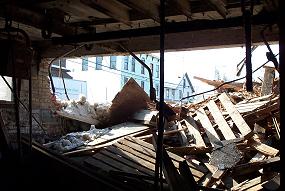What's Happening in the Fulling Room?
February 24, 2000
![]()
| On Wednesday, Rick Leighton took me around the
Eastland Woolen Mill cleanup site. We went into what used to be the
fulling room. I'm told
that after wool cloth is woven, the fulling process is the most important
part of finishing the fabric. The cloth is forced through a mill that
spreads out the threads and fills in the weave. This changes the cloth from
the coarse, burlap-like, open weave material that comes off the loom to
the soft, closed weave fabric we know as wool cloth. |
|
|
Remember the photograph from Tuesday morning? It showed the machine tearing down the front of the mill. This picture was taken at the same time. Just a few yards along the street, these people were carrying away material being passed out through a window from down in the fulling room. |
| |
|
| This is Jason Greenlee from Assonet, Massachusetts. He works for Charter Environmental, Inc. They are responsible for handling the non-asbestos, hazardous materials at the site. (Jason told me he checks The Cattail Press often.) Jason, and the people he works with, are removing the hazardous material from the fulling mill area. |
|
| |
|
|
|
|
| They have to dismantle the fulling mills. The metal parts become scrap but the wood is contaminated and requires special handling. Pits in the floor below the mills also contain hazardous material. The pits must be cleaned and even sandblasted to be sure all dangerous substances are gone. All of this material is carried to those covered containers just down the street. |
| |
|
 |
After photographing the workers, I turned around and walked about ten steps to take this picture. Now we know why the demolition on Main Street stopped to let the work in the fulling room continue. |
| I was very impressed with the safety precautions evident throughout the site. Worker safety is very important to these people. While the demolition wasn't very far away from the fulling room, they would never take any chance that might endanger the workers. |
![]()
![]()